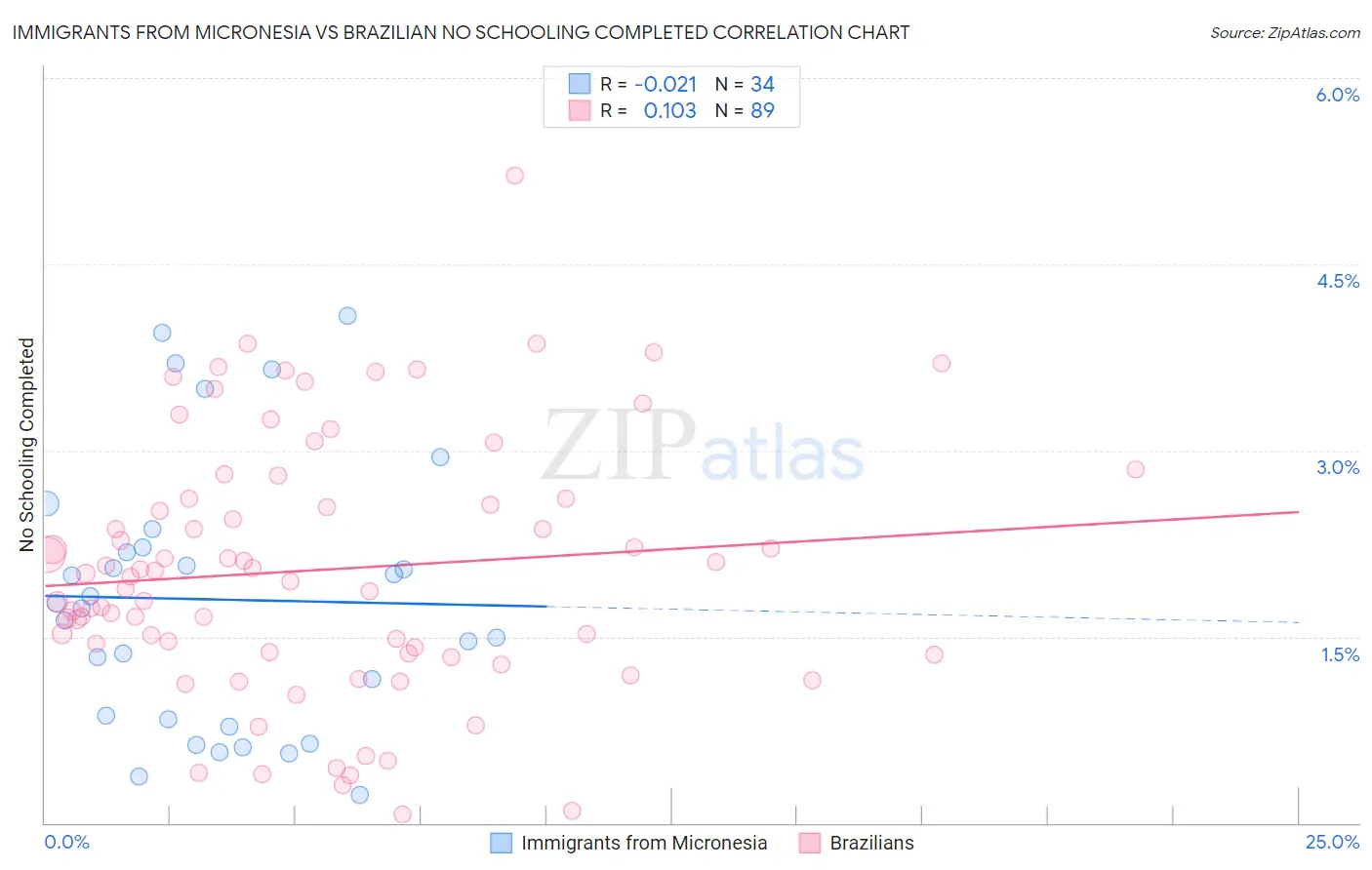Immigrants from Micronesia vs Brazilian No Schooling Completed
COMPARE
Immigrants from Micronesia
Brazilian
No Schooling Completed
No Schooling Completed Comparison
Immigrants from Micronesia
Brazilians
2.1%
NO SCHOOLING COMPLETED
50.0/ 100
METRIC RATING
174th/ 347
METRIC RANK
2.1%
NO SCHOOLING COMPLETED
60.2/ 100
METRIC RATING
165th/ 347
METRIC RANK
Immigrants from Micronesia vs Brazilian No Schooling Completed Correlation Chart
The statistical analysis conducted on geographies consisting of 61,387,395 people shows no correlation between the proportion of Immigrants from Micronesia and percentage of population with no schooling in the United States with a correlation coefficient (R) of -0.021 and weighted average of 2.1%. Similarly, the statistical analysis conducted on geographies consisting of 321,239,467 people shows a poor positive correlation between the proportion of Brazilians and percentage of population with no schooling in the United States with a correlation coefficient (R) of 0.103 and weighted average of 2.1%, a difference of 1.4%.

No Schooling Completed Correlation Summary
| Measurement | Immigrants from Micronesia | Brazilian |
| Minimum | 0.23% | 0.065% |
| Maximum | 4.1% | 5.2% |
| Range | 3.9% | 5.1% |
| Mean | 1.8% | 2.0% |
| Median | 1.7% | 2.0% |
| Interquartile 25% (IQ1) | 0.84% | 1.4% |
| Interquartile 75% (IQ3) | 2.2% | 2.6% |
| Interquartile Range (IQR) | 1.4% | 1.2% |
| Standard Deviation (Sample) | 1.1% | 1.0% |
| Standard Deviation (Population) | 1.1% | 1.0% |
Demographics Similar to Immigrants from Micronesia and Brazilians by No Schooling Completed
In terms of no schooling completed, the demographic groups most similar to Immigrants from Micronesia are Immigrants from Belarus (2.1%, a difference of 0.24%), Immigrants from Argentina (2.1%, a difference of 0.37%), Arab (2.1%, a difference of 0.48%), Panamanian (2.1%, a difference of 0.65%), and Arapaho (2.1%, a difference of 0.67%). Similarly, the demographic groups most similar to Brazilians are Dutch West Indian (2.1%, a difference of 0.050%), Comanche (2.1%, a difference of 0.060%), Egyptian (2.1%, a difference of 0.15%), Cheyenne (2.1%, a difference of 0.23%), and Albanian (2.1%, a difference of 0.28%).
| Demographics | Rating | Rank | No Schooling Completed |
| Immigrants | Spain | 66.4 /100 | #159 | Good 2.0% |
| Kenyans | 65.7 /100 | #160 | Good 2.0% |
| Ugandans | 64.6 /100 | #161 | Good 2.0% |
| Immigrants | Brazil | 63.8 /100 | #162 | Good 2.1% |
| Albanians | 62.2 /100 | #163 | Good 2.1% |
| Comanche | 60.7 /100 | #164 | Good 2.1% |
| Brazilians | 60.2 /100 | #165 | Good 2.1% |
| Dutch West Indians | 59.9 /100 | #166 | Average 2.1% |
| Egyptians | 59.2 /100 | #167 | Average 2.1% |
| Cheyenne | 58.6 /100 | #168 | Average 2.1% |
| Apache | 56.7 /100 | #169 | Average 2.1% |
| Argentineans | 56.0 /100 | #170 | Average 2.1% |
| Immigrants | Poland | 55.2 /100 | #171 | Average 2.1% |
| Immigrants | Argentina | 52.7 /100 | #172 | Average 2.1% |
| Immigrants | Belarus | 51.8 /100 | #173 | Average 2.1% |
| Immigrants | Micronesia | 50.0 /100 | #174 | Average 2.1% |
| Arabs | 46.4 /100 | #175 | Average 2.1% |
| Panamanians | 45.2 /100 | #176 | Average 2.1% |
| Arapaho | 45.0 /100 | #177 | Average 2.1% |
| Pakistanis | 44.7 /100 | #178 | Average 2.1% |
| Immigrants | Kazakhstan | 44.3 /100 | #179 | Average 2.1% |